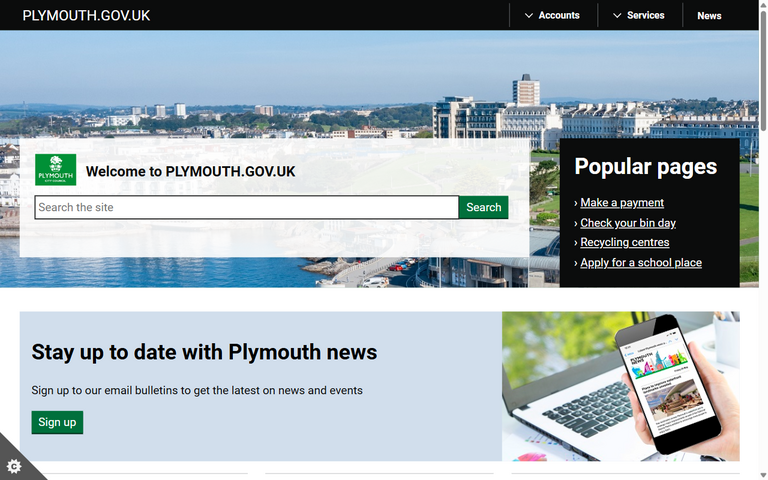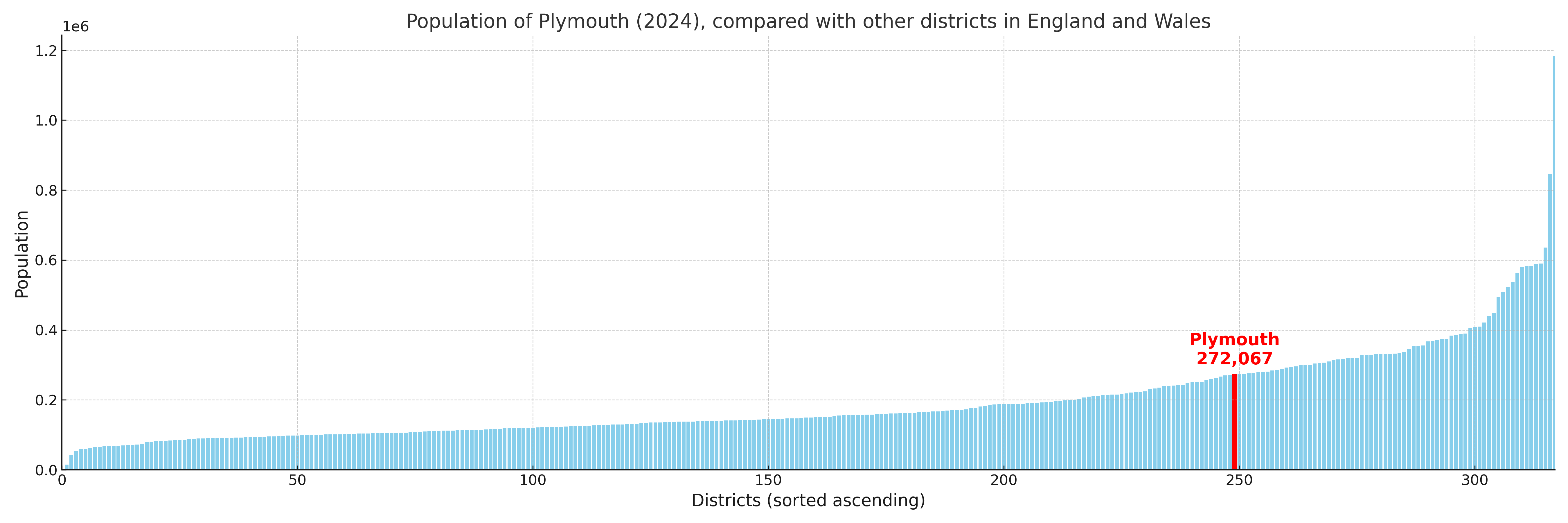Plymouth
§ This page gives an overview of the Plymouth local authority district, bringing together key facts, maps, and data to help you quickly understand the area. One of 361 district profiles on Baseview.
Overview ⁞ Plymouth is a coastal city in Devon, located between Dartmoor and the English Channel. Its historic harbour, the Hoe with views over Plymouth Sound, and the Mayflower Steps highlight its maritime heritage. The Barbican area preserves narrow streets, quays, and historic buildings, while the Royal William Yard and National Marine Aquarium add cultural attractions. The River Tamar forms a natural border with Cornwall, and the surrounding countryside includes moorland, valleys, and estuaries. Plymouth’s seafront setting and naval history define its character.
Plymouth Boundary Map
This map shows the official boundary of the Plymouth local authority district, based on the latest geographic data published by the Office for National Statistics (ONS). It provides a clear view of the district’s extent and helps you understand how the area fits within the wider regional and national landscape.
Contains OS data © Crown copyright and database right 2025. Source: Office for National Statistics licensed under the Open Government Licence v3.0.
The administrative boundary of Plymouth can also be viewed on OpenStreetMap: District Boundary of Plymouth.
Key Facts about Plymouth
What region is Plymouth in? Plymouth is in the South West of England, a region within the UK.
What county is Plymouth in? Plymouth is in the county of Devon.
Is Plymouth a city? Yes, Plymouth is a city. Plymouth holds official city status as one of the 76 designated cities in the UK.
Who governs Plymouth? The local government for this district is: Plymouth City Council (Unitary Authority).
▶ Official website of Plymouth City Council 🔗 plymouth.gov.uk

Which police force covers Plymouth? Policing in Plymouth is provided by Devon & Cornwall Police 🔗 devon-cornwall.police.uk, which serves 12 local authority districts: Cornwall ⁞ East Devon ⁞ Exeter ⁞ Isles of Scilly ⁞ Mid Devon ⁞ North Devon ⁞ Plymouth ⁞ South Hams ⁞ Teignbridge ⁞ Torbay ⁞ Torridge ⁞ West Devon.
Plymouth in International Geographies
In the International Territorial Levels (ITLs) hierarchy, Plymouth is an ITLs Level 3 area:
- (ITL 1) South West
- (ITL 2) ⇒ Devon
- (ITL 3) ⇒⇒ Plymouth
The International Territorial Levels are used by OECD member countries for statistical purposes to classify administrative areas. We have this listable page for easy browsing of ITL names and codes: International Territorial Levels.
Constituencies in Plymouth
Plymouth is divided into 3 parliamentary constituencies, listed below in alphabetical order.
A constituency is a specific geographical area that elects one Member of Parliament (MP) to represent them in the House of Commons. The United Kingdom is divided into 650 parliamentary constituencies. We have this list page for easy browsing of all UK parliamentary constituencies: List of Constituencies.
Wards in Plymouth
Plymouth is divided into 20 wards, listed below in alphabetical order.
- Budshead
- Compton
- Devonport
- Drake
- Efford and Lipson
- Eggbuckland
- Ham
- Honicknowle
- Moor View
- Peverell
- Plympton Chaddlewood
- Plympton Erle
- Plympton St Mary
- Plymstock Dunstone
- Plymstock Radford
- Southway
- St Budeaux
- St Peter and the Waterfront
- Stoke
- Sutton and Mount Gould
In the UK, a ward is a subdivision of a local authority area, used mainly for electoral and statistical purposes. Defined by the ONS, wards represent the primary unit for local elections, each returning one or more councillors to the local council. Wards are also used as a key geography for presenting population and census data.
Parishes in Plymouth
Plymouth is entirely unparished—there are no civil parishes in this local authority district.
Parishes are the lowest tier of local government; where they don’t exist, those very local services and representation sit directly with the principal council.
Built-up Areas in Plymouth
Plymouth covers 2 built-up areas, listed below in alphabetical order.
- Plymouth *
- Sherford *
In the UK, a Built-up Area (BUA) is a continuous urban area of at least 20 hectares (0.2 km²), defined by the ONS as land where buildings are generally no more than 200 metres apart, such as towns, cities, or large villages. (Note: A BUA name marked with an asterisk (*) indicates that the area is situated partly in the district of Plymouth.)
Plymouth compared with other districts in the UK
This section shows how Plymouth compares with other local authority districts in the UK, using a variety of measures and rankings.
Plymouth has 20 electoral wards.

Plymouth has a population of 272,067 (2024 mid-year estimate by ONS)

More local statistics and data for Plymouth can be found on the ONS statistics for Plymouth.